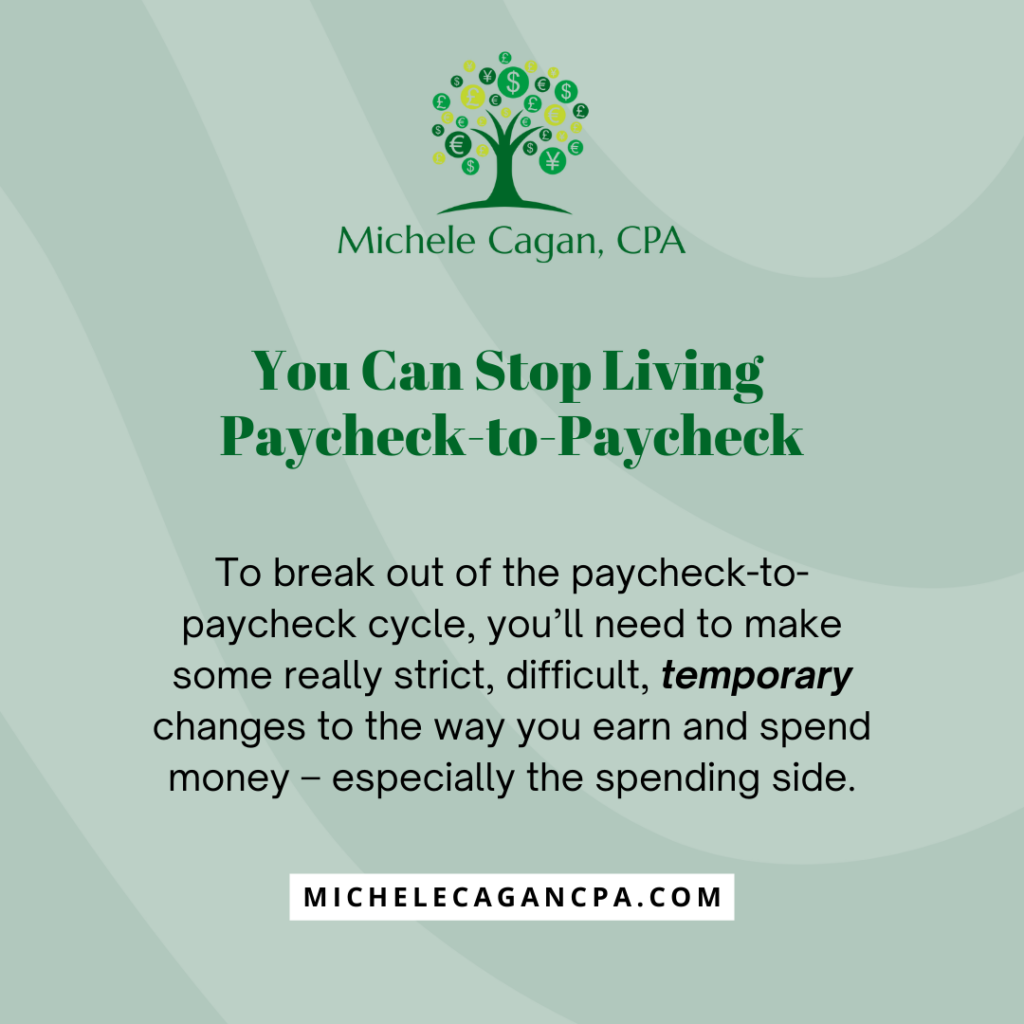Worrying about whether you can cover all the bills this month is one of the worst feelings a single mom can have. And knowing that you definitely can’t feels even worse.
When you’re living paycheck-to-paycheck, almost anything can knock your finances off course. A bigger than expected electric bill … a smaller than expected tax refund … a sick kid … a birthday party. You have to turn to credit cards, and that only makes next month’s bills even worse.
And no matter how much you’re earning, you can get stuck in this damaging financial cycle. It’s impossible to save any money, let alone start building wealth. And it keeps you trapped wherever you are right now. You can’t change jobs even if you’re unhappy where you are. You can’t afford to move – even to somewhere less expensive – when you’re stuck waiting for that next paycheck.
But there is a way to bust out of that cycle, build up savings, and start to create real wealth. All it takes is a plan.
Temporary budget mode
To break out of the paycheck-to-paycheck cycle, you’ll need to make some really strict, difficult, temporary changes to the way you earn and spend money – especially the spending side.

This calls for an emergency budget, one that adds cash from any possible source (like a second or third job) and slashes spending to the barest bones. I know this isn’t easy, but creating and sticking to this plan is the only way to get out of this destructive financial cycle.
And once you’re finally in better financial shape, you’ll be able to build up substantial savings and go back to spending money normally (but not over-the-top) without worrying about how the bills will get paid. For now, though, you’ll need to make some different choices for your kids and yourself.
Boost income any way you can
For many single moms, bringing in extra cash is much easier than trimming expenses – so many of us already watch our spending, and sometimes there’s really just nothing left to cut. Every dollar you bring in brings you a step closer to breaking the cycle, so do as many of these as you can to maximize your income. You can go the traditional route and get another job, or you can take a fresh approach to boosting monthly income…
- Try an online side gig that you can do while the kids are occupied or sleeping. One decent moneymaker: being an online juror. You can earn up to $60 for an hour of work helping lawyers test their cases before they face the real jury. Check out sites like Online Verdict and Resolution Research. Plus, Resolution Research also does online focus groups, for even more money-making opportunities.
- Go for a walk. Whether you take your kids on a nature hike, walk the dog, or get some steps in while the kids are at school, you can earn points – that turn into cash – for every step you take outside with the Sweatcoin app.
- Pick up some freelance work. No matter what your skill set is, you can find side gigs online through sites like Upwork, Indeed, and ZipRecruiter.
Free up budget space with smart cuts
Making strategic slashes to specific expenses – remember, these are temporary – can move your finances forward faster.
The first cut: Budget-busting fees you may not even realize you’re paying. They’re often small enough that you don’t really notice them, but stopping them cold turkey can free up some much-needed space in your budget. And since you’re spending this money on things you don’t want or need, you won’t feel a pinch from ditching them. These autopilot expenses and hidden fees most often show up in places like:
- Bank accounts, where monthly maintenance fees, overdraft fees, ATM fees, and paper statement fees can eat away at your account balance
- “Free trial” subscriptions that you never cancelled
- Library fines, which kick in when you forget to renew or return all the books and DVDs you took out for the kids (if they can even find them)
- Memberships you aren’t using (and what single mom actually has time to go to the gym regularly?)
- Cell phone bills, which may be charging for services or data that you aren’t using
Next up: Anything you don’t need to live … and that’s most stuff. During this temporary budget freeze avoid stores, malls, restaurants – anywhere that you could be tempted to spend money, and that includes online shopping. If you avoid shopping venues, you won’t fall prey to retailer tricks (like free shipping if you spend $$$ or buy-two-get-one-free deals) that trap you into spending more than you planned.
When you do have to buy something, make a definitive list (even if there’s only one item on it) before you shop and stick to it. If what you need is a bigger ticket item, shop around before you buy so you can get it for the lowest possible price (check out a site like PriceGrabber).
Finally: Minimize your must-have expenses however you can. You can’t eliminate spending on food, shelter, medical care, and transportation … but you can stick to spending on a smaller scale. On this temporary, super-strict budget, food (for example) means basic groceries only – no restaurants, take-out, prepared foods, or junk food. Transportation cutbacks could mean anything from walking or biking more, to carpooling, to trading in your car for a less expensive one, or temporarily changing your car insurance to the barest possible policy.
Cutting back on housing costs – usually a single mom’s single biggest expense – doesn’t only mean finding a cheaper place to live, although that can go a long way toward dramatically changing your financial situation. You can also learn how to do basic home repairs to save money on maintenance … switch to a programmable thermostat (like Nest) to trim energy bills. You can also visit the U.S. Department of Energy website to find lots of easy energy-saving ideas to implement.
Minimize credit card costs
Credit card fees and interest can decimate a single mom’s budget – and paying down credit card debt can help reduce those costs substantially. Even if you can’t pay off your credit cards right now, you can still do some things to lower the balance faster, and that also means paying less interest – which can save you thousands of dollars over time.
Here are three easy ways to start reducing your credit card debt and interest payments:
- Pay on time, every time. Late payment fees increase the balance that you’re paying interest on, so a single $39 late fee could end up costing more than $100. Worse, making your credit card payment even one day late will knock you into a higher interest rate, meaning you’ll suddenly be paying much more interest on the same exact balance.
- Make smaller, multiple payments during the month. Credit card interest is charged on your average daily balance. If you split your payment into two (or more), and start sending them earlier in the month, you’ll reduce your average daily balance and your interest charge. Sending $50 on the 5th and the 25th is better than sending $100 on the 25th. Weird but true.
- Always pay more than the minimum payment. Doesn’t matter if it’s only $5 extra, it will help. Making more than the minimum payment every month will reduce your balance faster, knocking time and interest off of your debt. The more you pay every month, the sooner you’ll pay down your credit card debt, and the less you’ll pay in interest.
Paying down credit card debt is the surest way to lift yourself out of the paycheck-to-paycheck cycle. The trick is to pay it off and never build it back up, which can be really hard to do. You’ll find a lot of ways to tackle your debt and avoid adding in new debt here.
It’s hard to stop living paycheck to paycheck – and it doesn’t happen overnight. It takes time and focus, but you can get there. My blog is full of helpful information, beyond the posts I’ve linked to in this one. Check out the categories on the right to see other topics I’ve written about.
I also have an entire book dedicated to problems just like the ones you’re suffering from now. It’s called The Financial Recovery Workbook and I wrote it to help you recover from any financial crisis, whether it’s a medical emergency, a divorce, or life in general.
The Financial Recovery Workbook provides a step-by-step guide to help you make a plan to get your financial life back on track. I use these techniques regularly with my clients, and I’ve used them myself when I’ve gone through financial disasters.
Click on the button below to find out more about The Financial Recovery Workbook and get your own copy, so you can stop living paycheck-to-paycheck and establish a stable, prosperous financial life.
I know how hard it is to live paycheck-to-paycheck because I’ve done it myself. That’s why I recommend buying this book – because I know it will help you get out of this horrible cycle just like it did for me.

